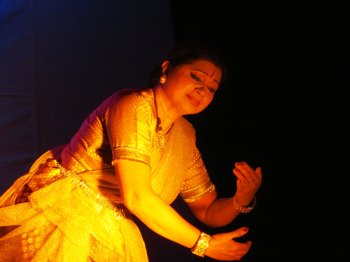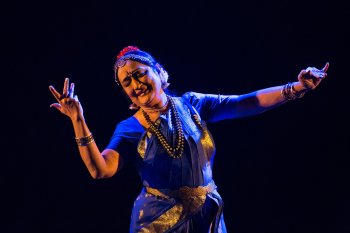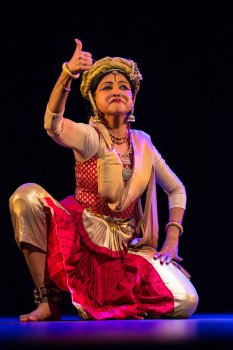
|   |

|   |
Natya Darshan Seminar EPIC WOMEN - Conference / Performance conclave Dec 23: Epic Women performances Photos: Vipul Sangoi December 25, 2012 Hidimba’s motherly love  (Photo: Lalitha Venkat) The third and final day of the conclave’s evening performances opened with well-known Kathak dancer Rajashree Shirke presenting a freshly choreographed item on ‘Mata Hidimba.’ She calls this new form of art ‘Ranga Nritya’ which is an excellent alliance of classical Indian music and Indian theatre. Last year at the ‘Mad and Divine’ conference, Rajashree had presented a fabulous production on the Maharashtrian poet saint Kanhopatra. That production continues to be fondly remembered by everyone who attended that conference. This year, Rajashree and her excellent group of dancers and musicians came back with double vigor and excitement to present Mata Hidimba. Rajashree who took on the role of the sutradhaar and later the role of Mother Hidimba had everyone in the hall attentive from her very first entry on stage. Her abhinaya for the tragedy of Mata Hidimba’s son’s death in the Kurukshetra war was one of the best in this conference. In addition to her superb acting one also heard excellent music by her group of dancers, who are all equally well-trained singers. Everyone was awestruck by the end of the production and by Rajashree’s depiction of the pathos and sadness of a mother’s devastation at the loss of her only son. She had everyone’s attention and her performance in this new work was a grand success. Mothers from two eras  The next performance for the evening was by renowned dancer, scholar, writer, commentator Lakshmi Vishwanathan. Known for her excellent abhinayam and her virtuosity, Lakshmi presented ‘Pulambal.’ As announced this is a word difficult to translate directly into English language. The closest meaning one could come to is ‘anguish.’ Presenting the story of mother Yashoda who misses her son Krishna and queen mother Kausalya whose feelings for Rama are inexplicable, Lakshmi’s abhinaya was flawless. Dressed in a wonderful blue, the colour that suits both the characters of Rama and Krishna, Lakshmi became the uniting force with her dance and choreography. Taking her inspiration from the writings of Kulashekara Alwar, Arunachala Kavi and Kamban, Lakshmi interwove the poems into her choreography. Yashoda’s lullaby to Krishna speaks of her subtle jealousy for others while Kausalya’s lament was hard-hitting in the scene where she insists she will follow Rama into his Aranyavaasam. Unable to bear the pain of separation, Lakshmi portrayed the role of Kausalya in a very powerful way. In her dance on these two epic mythological women, Lakshmi too joined in the league of an epic dancing queen at the conference’s evening performances. Some wonderful musicians too aided in this production’s success. Panchali’s vow  Urmila Sathyanarayanan’s ‘Panchali Sapatham’ was an ambitious, dramatic performance enacting the famous gambling scene and the disrobing of Draupadi by Dushasana in the Mahabharata. It teaches us how base human emotions lead to injustice, despair and destruction. Urmila’s rendition of the several scenes leading up to the humiliation was done with energy and effective facial expression. The performance depicted Draupadi as a woman of high esteem, one who displayed grit and courage and ultimately surrendered to the divine supreme displaying one of the loftiest forms of bhakthi. The music for this production was composed by Lalgudi G Jayaraman. The lyrics in Tamil were by Va Ve Su, inspired by the work of Subramanya Bharathi. However, one did wonder at Urmila’s choice of costume design. The evening came to an end with Urmila commending the organizers for clean green rooms and excellent hospitality. |